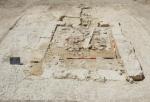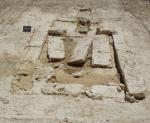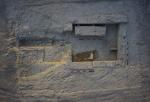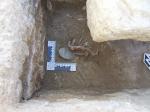Summary (English)
In July, 2019, archaeologists from the University of Perugia and Kent State University in a field on the northwestern area of the necropolis, on a hillside sloping down to the tributary of the Tiber, discovered a ca. 3 × 4 meter quadrangular tomb, constructed of large travertine blocks without the use of mortar.
Within the tomb, three long, rectangular cut travertine stones appeared parallel to the side walls and most likely functioned as funerary “benches” upon which the bodies of the deceased were laid, similar to the benches carved into the natural rock in the chamber tombs common to the necropolis. Small vertical stone supports were discovered underlying both of these stones. In addition there was another support stone along the rear wall of the tomb, perhaps to support a wooden shelf for funerary goods, based on comparisons with chamber tombs with stone shelves discovered elsewhere in the necropolis. The long center stone, based on the position and size in comparison to the entrance, was likely used to close the entrance.
The bench on the right (eastern) side was thinner, shorter and not perfectely squared like the other bench. Carved on the surface were several cup shaped carvings and small grooves, resembling those found on Etruscan altars; possibly the stone originally was used as an altar and was subsequently repurposed in the tomb as a funeral bed.
In front of the tomb’s entrance was a drainage channel, likely constructed after the tomb was opened and a new body deposited sometimes between the fifth and fourth centuries B.C. Probably at that time, it was discovered that the tomb was suffering from flooding, which was true of the majority of tombs discovered in the necropolis.
The tomb is quadrangular with an entrance on the south side but the roof and the upper courses of the walls of the structure were not preserved. A triangular travertine block discovered in the drainage channel may have originally been placed above the architrave of the entrance and functioned as the tympanum of the structure, suggesting a gabled roof, so possibly it was a tomba a edicola. Another possibility is a tomba a dado.
Although the tomb was damaged by flooding and agricultural activity, and likely robbed in antiquity of its most impressive artifacts, a great quantity and variety of ceramic and metal items, as well as human bones were found. Pottery dating from the sixth to the late fifth/beginning of the fourth centuries B.C. included many fine wares such as Etruscan bucchero and painted wares, imported Attic black figure, and minaturistic forms, including Etrusco-Corinthian examples. Remarkable metal artifacts included iron spits, circular bronze studs for wooden furniture, a silver fibula, a bronze ring, and a trove of iron weapons. Close to or beneath the stone benches were found a decorative bronze disc with a central black gemstone, a gold ring with an engraved image of a fantastic animal, likely a hippocamp, and the head of an iron scepter with a hole for the wooden shaft.
- Sarah M. Harvey (Kent State University)
Director
- Gian Luca Grassigli (University of Perugia)
- Sarah M. Harvey (Kent State University)
Team
- Francesco Pacelli
- Stefano Spiganti
Research Body
- Kent Sate University
- Università degli Studi di Perugia
Funding Body
- Comune di Montecchio
- Kent Sate University
- Università degli Studi di Perugia






![Download [PDF]](/excavation/skins/fasti/images/results/download_sml.png)


